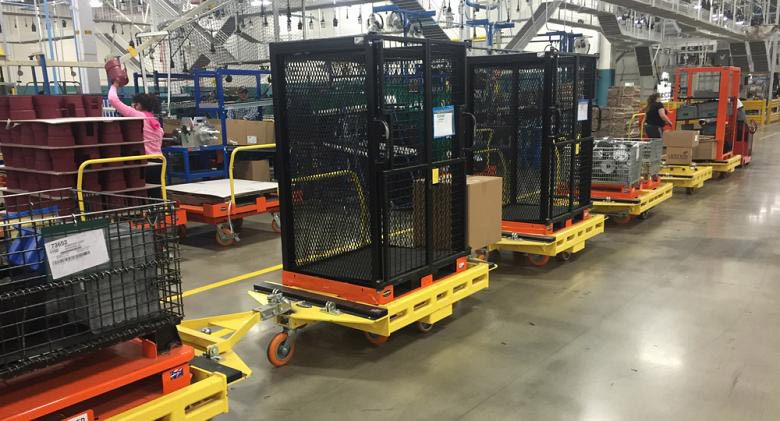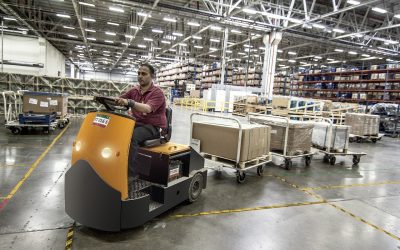Fork truck free / forklift free is all the rage right now. Every industry publication, trade show discussion group, and cart manufacturer in the country is talking up the benefits of eliminating forklifts. It’s like Industry 4.0 – except it actually works.
For companies that have plant scoring systems, many of the steps to forklift free have specific points assigned to them. Buy a tugger – plus 1! Run your first cart loop – plus 3! Set lineside min/max cart levels – plus 5!
The rationale behind forklift free seems obvious. Forklifts are dangerous and only move large containers. Tuggers are less expensive than forklifts and can move multiple carts at one time, holding any size container. High-quality tug carts are readily available from many sources.
Yet with all that knowledge and momentum behind forklift free, most companies do not see meaningful results from their forklift free initiatives. Why?
There are dozens of different factors that come into play for every company. One of our clients took more than a year to work through the union job classification changes to transition forklift drivers to tugger drivers. That’s obviously a unique case and every plant will have something tricky to work through, but what key factors apply to everyone? What can be done to make implementations successful?
We analyzed our interactions with companies along the forklift free spectrum from “thinking about it” to “struggling to make it work” to “full, successful implementation” and identified three controllable success factors. The word controllable is important because factors like culture, plant history, and new product launches all matter and have influence, but you can’t control them, only work with them. Business continues as normal, so what can you do to successfully implement in the midst of it all?
Use a method. Real forklift free means changing things, processes, and systems at the same time.
It’s easy to start with the things – carts, tuggers, boxes – and get stuck there. It can feel fun, just like buying a new car. Should the tugger be stand up or sit down? Which brand? Tow carts or mother daughter? Fabricated or modular? Current packaging or build a repack cell? The list goes on and you can deceive yourself into thinking you’re making real progress when you have answers to questions about things. But if you achieve forklift free and all that has changed are the things, you’ll find what didn’t change very much are your results. Yes, you’ve restricted forklifts to shipping, which is good, but you haven’t seen the real power of what’s possible for improvements in productivity and reductions in inventory, lead time, and floor space.
Using a method addresses the opportunity from two sides: understanding systemic change and putting your current activity in context. At a high level, most implementation methods follow similar steps like visualize, analyze, plan, transform, stabilize, and repeat. Success comes when you combine a structured, detailed method with a team that has substantial transformation experience which provides context to do the right work in the right order.
Appoint an owner. Assign one person who is accountable for results.
A version of the saying “If everybody’s in charge, nobody’s in charge” is probably known in all languages. One of the challenges of forklift free is that it impacts everyone from operators to the general manager. No single management role owns every aspect of it, but all own part of it – production, logistics, and every engineering group. Of course, you could say that the general manager owns it, but the level of attention needed at the implementation level is too much of a distraction for the rest of their critical work. The solution is to create a task force of main people and to appoint one person as the owner for the duration of the project. That person needs to have a temporary direct line to the plant manager, if they don’t already, to access roadblock-busting power on demand. Typically someone in materials / logistics is the most logical as long as they have the tenure, relationships, and approach to handle the role, but candidates from other departments can do well also as long as they have the right knowledge and support.
See the future. Plan two steps in advance to guarantee forklift free happens in the right direction.
Nobody here is Nostradamus. We’re not saying to predict the future. We’re saying you need to see it. Forklift free is very well known and seems to make so much sense, companies move it to the top of the priority list without fully understanding the order of improvement needed. After a structured business review, many of our clients who had forklift free as their top priority moved it to step two or three because they weren’t as stable or capable in production as they needed to be or that integrating a new line launch needed to be the manpower focus. Really understand and address the needs of the business first. Then, once you’re sure that forklift free is the right thing to do, you need to know how you want to approach it.
Essentially there are two paths to achieve forklift free: outside in or inside out. Outside in works from the aisle into the production area, dropping in a bunch of carts and tuggers to eliminate forklifts. It’s the fastest way to start, but limits progress on the next improvement step because you only changed one variable – forklifts. Inside out works from the production area out to the aisle. Forklift free then becomes a consequence, an outcome, of a plan to improve multiple variables (productivity, packaging, inventory, floor space, work patterns) while also eliminating forklifts in the process. This also sets up the next level of improvement because many parts of the system have improved together.
It’s clear when you walk a plant and see dozens of forklifts racing around that you are not in a lean operation. It’s an easy and equally obvious step to make the statement to “Get the fork outta here” and eliminate forklifts. The challenge is to eliminate forklifts with the correct method while setting the business up for continual, dynamic improvement. The opportunity to create meaningful change with the effort is huge and no words, images, or videos can come close to describing what it takes. Be sure the effort will be worth your time and hopefully these guidelines will provide some measure of support on your journey.
Geolean is a world leader in lean implementation and passionate about improving people, processes and products to help manufacturers thrive. Our transformation model has created 200 (and counting!) successful lean implementations worldwide using these primary principles:
- Practices are grounded in the Toyota System
- Changes are made in real time with the people involved
- Effort yields sustainable results
In addition to complete lean systems, we provide focused integration support to plant transformations, new product launches, forklift free initiatives, and engineered material flow projects. Apply the power of Geolean’s system to achieve your organization’s full potential!
This article was originally featured in the Magna Corporation August newsletter.



